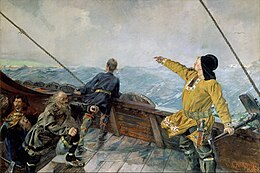Maine penny

| Part of a series on the |
| Norse colonization of North America |
|---|
 |
The Maine penny, also referred to as the Goddard coin, is a Norwegian silver coin dating to the reign of
Discovery
Guy Mellgren, a local resident and amateur
The coin
Much of the circumstances of the finding of the coin were not well preserved in the record (as was the case with the majority of the 30,000 finds). The coin was at first misidentified as a
Norse origin
The Goddard site has been dated to 1180–1235, within the circulation period of pennies of this type. The people who lived at the site at that time are generally considered to be ancestors of the
The penny's coastal origin has been offered as evidence either that the
The Maine State Museum website favors the view that the coin was found at the site and is therefore evidence of Norse presence on the North American continent, although the Museum states "the most likely explanation for the coin's presence is that it was obtained by natives somewhere else, perhaps in
However, the possibility that it may be a hoax has been raised. Notably this Norwegian silver coin and other similar coins of that era were available on the open market during 1957. Thus Mellgren could have had the means and the opportunity to plant the coin at the site, or he could have been deceived by someone planting the coin – though it is unclear what the motive would have been.[9] There are enough questions regarding the provenance of the coin to leave its archaeological significance unclear.[10] An assessment of the validity of the find by anthropologist Edmund Snow Carpenter concluded: "Not proven".[3]
Robert Hoge, writing for the American Numismatic Society in 2006, stated that "There is no reliable confirmation on the documentation of the Goddard coin, and much circumstantial evidence suggests that someone was deliberately trying to manipulate or obfuscate the situation. The Norse coin from Maine should probably be considered a hoax."[9]
A November 2017 paper by Norwegian numismatist Svein Gullbeck suggests that the coin is a genuine find.[11]
References
- ^ "The Viking "Maine Penny" Mystery". Thor News. February 21, 2014. Retrieved October 15, 2015.
- The History Channel. February 21, 2014. Retrieved October 15, 2015.
- ^ a b c Carpenter, Edmund (2003). Norse penny. Rock Foundation.
- Time Magazine (Vol. 112 No. 24). December 11, 1978. Archived from the originalon October 27, 2007.
- ^ "Vinland Archeology". naturalhistory.si.edu. Smithsonian Institution. Archived from the original on March 8, 2018. Retrieved 17 May 2018.
- ^ Sutherland, Patricia. (2000) The Norse and Native Norse Americans in William W. Fitzhugh and Elisabeth I. Ward, eds., Vikings: The North Atlantic Saga (pp. 238–247. Washington, DC: The Smithsonian Institution)
- ^ The Norsemen in Greenland: Recent Discoveries at Herjolfsnes by William Hovgaard (Geographical Review. Vol. 15, No. 4, Oct., 1925, pp. 605–616)
- ^ a b "The Goddard Norse Coin". Maine State Museum. Archived from the original on 2009-11-19.
- ^ a b "Current Cabinet Activities". American Numismatic Society. Spring 2005. Archived from the original on July 2, 2015.
{{cite web}}: CS1 maint: unfit URL (link) - ^ Prins, Harald E.L., and McBride, Bunny, Asticou's Island Domain: Wabanaki Peoples at Mount Desert Island, Maine, 1500–2000 (Vol.1., pp. 40–42. Boston: National Park Service, 2007) (PDF)
- S2CID 165460499.
Other sources
- ISBN 9788200015420
Related reading
- Bourque, Bruce (2004) Twelve Thousand Years: American Indians in Maine (University of Nebraska Press) ISBN 9780803262317
- Carpenter, Edmund (2003). Norse penny. New York: The Rock Foundation.
- Haviland, William (2012) Canoe Indians of Down East Maine (The History Press) ISBN 9781609496654
- Hovgaard, William (1914) The Voyages of the Norsemen to America (New York: The American-Scandinavian Foundation)
- Kolodny, Annette. (2012) In Search of First Contact: The Vikings of Vinland, the Peoples of the Dawnland, and the Anglo-American Anxiety of Discovery. (Durham & London: Duke University Press)
- Prins, Harald E.L.; McBride, Bunny (2007) Asticou's Island Domain: Wabanaki Peoples at Mount Desert Island 1500–2000. (Boston: National Park Service)
- Richard, Wilfred E.; William Fitzhugh (2014) Maine to Greenland: Exploring the Maritime Far Northeast (Smithsonian Institution) ISBN 9781588343796
External links
- "Maine Penny (image)". Maine State Museum. Archived from the original on 2003-02-03.
- Maine State Museum website
- The Mystery of Maine’s Viking Penny
